Blog
Archives
.
. . from 2012 to current
SATURDAY
OCTOBER 31 - 2015
Millpond
Swans
I had a walk
around the town millpond this morning. The four swan
cygnets were on the pond as usual, even though they
had been reported flying around. I don't know where
the 5th cygnet went, though I did see a lone cygnet at
Nore Barn a couple of weeks ago which could have been
it. The regular nesting Mute Swan pair was on the pond
along with the visiting pair further south. The
resident swans were closely monitoring a lone swan on
Bridgefoot Path, which is probably the same bird that
lived here for much of last winter. It will not be
allowed on the pond.
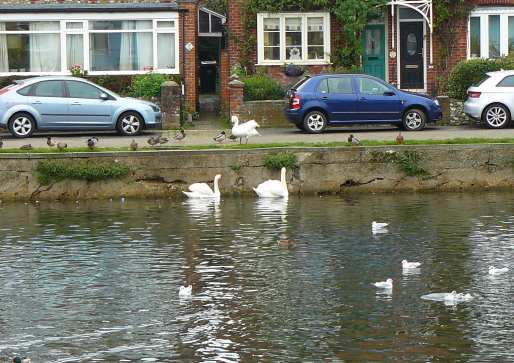
Brent
Geese
From the
millpond seawall, I noted about 50 Brent Geese in the
eastern harbour, but there was not a single juvenile
among them.

The absence of
juveniles this winter supports Ralph Hollins's
contention that this is likely to have been a poor
breeding season for the Brents. Peter Milinets-Raby
could only find one juvenile among 381 Brent Geese
during his comprehensive survey of the coastline from
Emsworth to Langstone this morning - see full report
below. Later this afternoon I met Barry Collins on his
way home from carrying out the monthly WeBS count on
Thorney Island. He had seen a few Brent juveniles, but
thought more could arrive later as Brent families are
often the last to turn up.
Brook
Meadow
This afternoon
I strolled through Brook Meadow and down to Peter
Pond. There was still no sign of the injured Pike in
the river which makes me wonder if it has succumbed to
the forces of nature. Great Spotted Woodpecker is
prominent around the meadow, mainly through its loud
'tchiking'. I met a couple of birdwatchers who
reported seeing three Kingfishers flying across Peter
Pond.
I made a list of 34 flowering plants on my walk as
follows: Annual Meadow-grass, Black Medick, Bristly
Ox-tongue, Cat's-ear, Cocksfoot, Common Chickweed,
Common Comfrey, Common Field Speedwell, Common Mallow,
Common Nettle, Daisy, Dandelion, Dogwood, False
Oat-grass, Fat Hen, Gorse, Groundsel, Hedge Bindweed,
Herb-Robert, Hoary Ragwort, Hogweed, Ivy, Knotgrass,
Michaelmas Daisy, Mugwort, Nipplewort, Purple
Toadflax, Red Campion, Red Clover, Smooth Sow-thistle,
White Dead-nettle, Wild Angelica, Wild Carrot, Yarrow.
Diseased
Goldfinch
Goldfinches
are very common visitors to the bird feeders in my
garden, though I have not previously seen one which
was clearly in some distress until today. The bird is
shown in the photo on the left. Its head lacked the
usual vivid black and red plumage of normal birds and
it was very lackadaisical. The poor bird just sat
there on the seed holder perch for several minutes
hardly moving and only occasionally taking food. See
the difference in the general demeanour of the poorly
bird (on the left) and and the normal ones (on the
right).
Emsworth
to Langstone
Peter
Milinets-Raby was out this morning to walk from
Emsworth to Langstone Mill Pond (6:33am to 10:43am -
low tide).
Emsworth Mill Pond (from 6:44am); 8 Coot, 8 Mute Swan,
1+ Pied Wagtail, 1 Grey Heron.
Emsworth Harbour: 17 Coot, 6 Grey Plover, 1 Buzzard
low over, 1 Greenshank, 1 Kingfisher perched on anchor
rope overlooking channel, 49 Black-tailed Godwit, 162
Brent Geese, 9 Turnstone, 7 Ringed Plover, 3 Little
Egret, 25+ Dunlin, 1 Great Black-backed Gull, 3+
Skylarks over (all heard).
Off Pond outflow (7:10am): 1 Little Egret, 5 Brent
Geese, 1 Greenshank, 2 Turnstone.
Off Beacon Square (from 7:20am): 13 Brent Geese, 93
Teal, 2 female Pintail and a pair flew over heading
east, 3 Pied Wagtails, 1 Grey Plover, 46 Black-tailed
Godwit, 1 Goldcrest in the gardens, 24 Goldfinch
over.
Nore Barn (from 7:32am): 116 Teal, 13 Wigeon, 42 Brent
Geese, 2 Black-tailed Godwit in the stream, 1 Grey
Plover, 8 Shelduck,
Warblington Farm (from 7:58am): 2 Green Sandpiper flew
over constantly calling and headed east towards the
cress beds - lovely sound. 6 Pied Wagtails, 1
Goldcrest.
Ibis Field (from 8:02am): 6 Moorhen, 1 male
Pheasant,
Conigar Point (from 8:10am - low tide and mud empty):
Two shooters with three gun dogs running around all
over the mud. Just packing up. I chatted to them when
they reached the shore. They had bagged three Wigeon
and two Teal.
As the dust settled . . . 78 Brent Geese, 25 Lapwing
flying east, 4 Shelduck, 9 Wigeon over east, 3 Grey
Plover, 1 Canada Goose west along the channel, 18+
Skylark over east (7, 3, 6 & 2 heard), Siskin
heard going over,
Tamarisk Hedge: 1 singing Chiffchaff, 3 Reed Bunting,
1 female Black Redstart perched very briefly on sea
wall. Chased off very quickly by a Robin and lost to
view in the Tamarisk Hedge (a new addition for me to
the area).
Off Pook Lane (from 8:45am): 81 Brent Geese - one pair
close to the shore had a young bird (see photo). Could
this be the only youngster of the summer (tongue
firmly in cheek, but I only had a handful of
youngsters all morning).
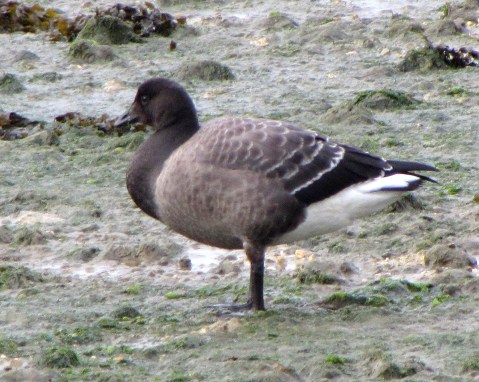
127 Bar-tailed Godwit,
150+ Dunlin - very flighty, 25 Teal, 3 Shelduck, 10
Stock Doves, 7 Greenshank (RG//-+YY//-), 7 Grey
Plover, 17 Knot, 37 Lapwing, 111 Golden Plover , 5
roosting Sandwich Tern, 17 Common Gull, 82
Black-tailed Godwit (R//R+RG//- & Y//R+YB//-), 2
Skylark over east.
Langstone Mill Pond (from 9:45am): 3 Teal, 1
Chiffchaff heard. No sign of the little duckling.
Could be bad news, but will not announce it's demise
until my next visit as it has a habit of hiding in the
reeds! Pair of Mute Swan - no juveniles to be seen! 2
Little Egrets and 2 Grey Herons roosting.
WEDNESDAY
OCTOBER 28 - 2015
Pond
Skaters
About 8 Pond
Skaters were rushing around on the surface of the
Westbrook Stream immediately beneath the small bridge
over the stream at Victoria Road. I often see them in
this section of the stream when it is slow moving,
though usually not this late in the year. However, I
gather they are active until the end of November when
they hibernate. They emerge from hibernation in April
and lay eggs, which hatch soon after. The nymphs go
through a number of moults. Here is a photo of three
of them in the stream that I took earlier this year.

Stinkhorns
in Nore Barn Woods
Roy Ewing was
excited to come across two Stinkhorns (Phallus
impudicus) in Nore Barn Woods today. He says
they may not be a rarity, but they are the first he
has seen in these woods. The fungus gets it common
name from the harsh pungent smell; this attracts flies
and other insects which help to disperse the spores.
There is a picture on the following site of a
Stinkhorn head covered in flies . . . .
http://www.first-nature.com/fungi/phallus-impudicus.php
I was interested to read that Stinkhorns begin their
development as oval or round structures known as
"eggs", which do not smell and which apparently are
edible. Here is Roy's photo of one of the Stinkhorns
in Nore Barn Woods. So, keep a nose out for
them.
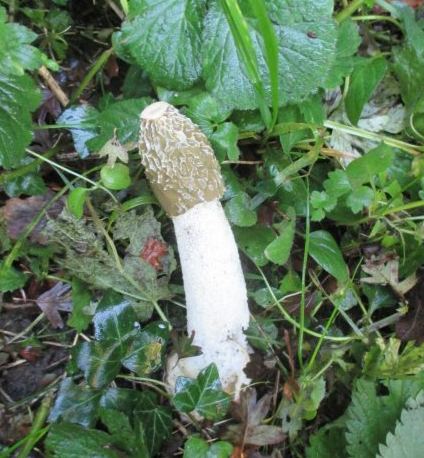
TUESDAY
OCTOBER 27 - 2015
Stansted
Forest
Jean and I had
a stroll through the east side of the Stansted estate
on a lovely warm morning. After coffee and scone at
the Pavilion Cafe, we walked along the path in front
of Stansted House where lots of Burnet-saxifrage
was in flower. This is a late flowering white
umbellifer, rather like Cow Parsley, but with finely
cut stem leaves which have long winged sheathing
stalks.
The large clusters of
Ivy flowers at the far end of the path were attracting
Honey Bees with yellow pollen sacs on their legs.
Sorry, you can't see them on this photo, but the
flowers were splendid.
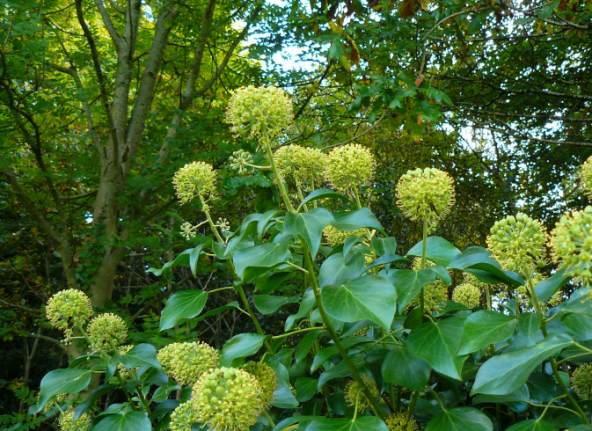
We went on up the
tarmac drive towards the Iron Gate Cottages where the
the trees full of autumn colour. What a glorious time
of the year this is.
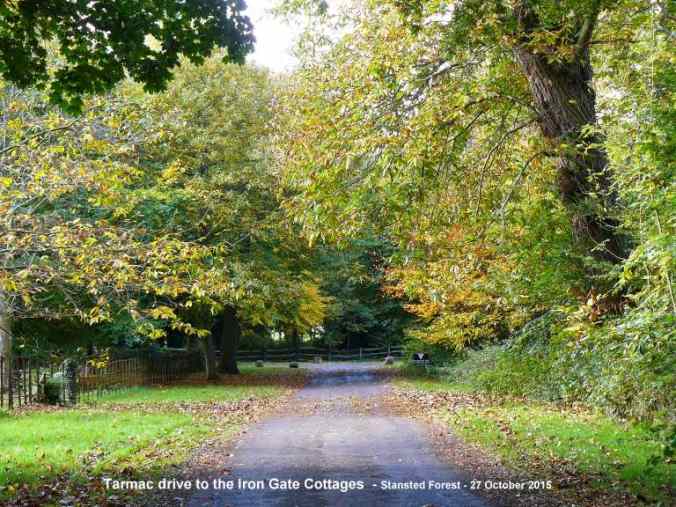
There were lots of
Sweet Chestnuts on the ground on the tarmac
drive towards the Iron Gate Cottages, but quite small
and hardly worth picking up.
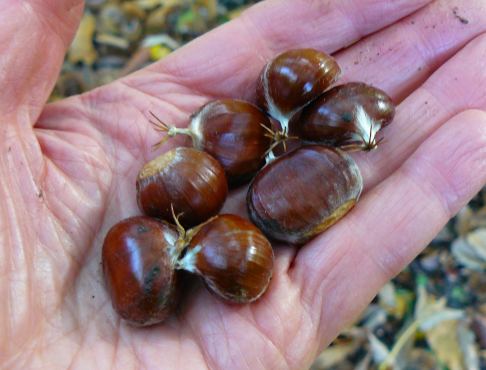
The yellow and brown
Maple leaves created a fine mosaic of colour on the
ground near the cottages.
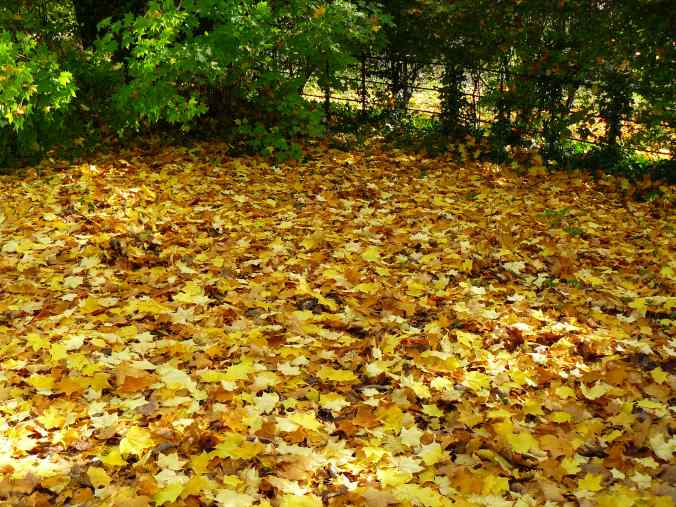
We went up the hill as
far as the twin Oaks where I had my traditional photo
taken. I still can't push them over!
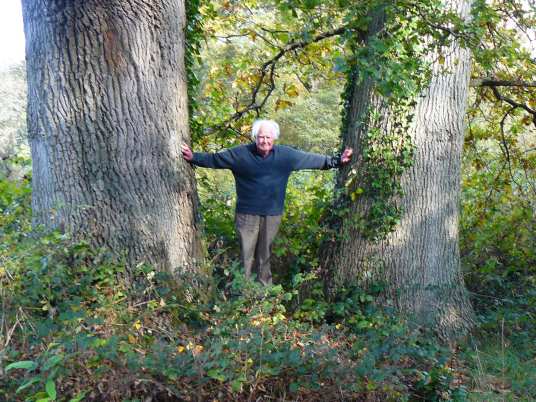
Farlington
delights
Colin Vanner
tyells me that he does not out all that often with his
camera, but when he does he certainly gets some
cracking images of fine birds. On Sunday Colin went
round Farlington Marshes and found the Bearded
Tits were showing very well in groups of up to 20
in the reedbeds. Ralph Hollins was also on Farlington
Marshes on Sunday and got a good view of these
delightful birds in the reeds around the lake.
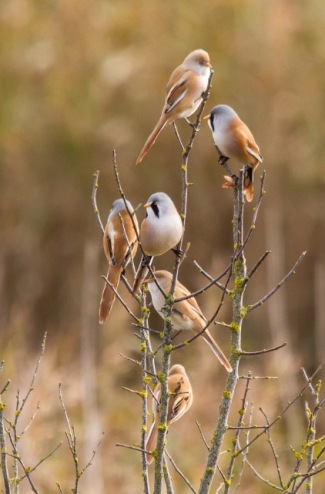
However, Colin's most
exciting bird was a Dartford Warbler which he
has not seen there before. Although Dartford Warbler
is common in SW Europe, it is rare in Britain, being
mainly confined to dry lowland heaths in Southern
England. I have seen one on Farlington Marshes in the
past, but it is by no means common, as it is in the
New Forest. Colin noted that it was not yet written up
on sightings board. Maybe he was the first to see it?
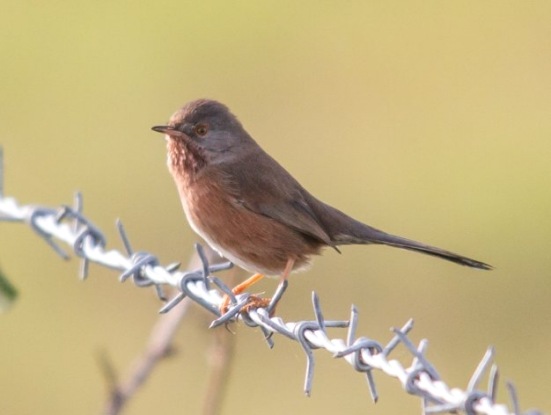
Spring
flowers
Tony Wootton
found some Cowslips flowering in the lawn at
West Dean gardens today. What are they trying to tell
us?

MONDAY
OCTOBER 26 - 2015
Millpond
Swans
Following a
report that one of the millpond swan cygnets went
walkabout up Bridge Road last Friday, I checked them
this morning. I found all four remaining cygnets
swimming contentedly around on the millpond with not a
care in the world, though their father cob was still
actively engaged in preventing the visiting pair of
swans from crossing an invisible line across the pond
from the end of Nile Street.
The 'Polish' cygnet is now almost completely pure
white and not easy to separate at a distance from its
parents, though it has little in the way of a knob on
the top of its bill and its legs and feet are pink.
The other three cygnets are in various stages of
developing their white feathers. All cygnets look
strong and are probably nearly ready to leave the
millpond to make their own way in life. Here is a shot
of the Polish cygnet with two of its siblings near the
steps at the bottom of School Lane.

SUNDAY
OCTOBER 25 - 2015
Mystery
godwit - solved
Pete Potts and
Ruth Croger came to Emsworth on Friday Oct 23 to
search for the colour-ringed Black-tailed Godwit with
an unusual colour combination that I saw at Nore Barn
on Thursday Oct 22. They found it over in the eastern
harbour below Emsworth Yacht Basin/Marina close to the
bank. They confirmed the colour combination as B+BL,
though it really looks nothing like that now as the
rings have faded badly over the years. However, the
bird is distinctive in that its red tarsus ring on the
left leg is missing and also that it has a bent
partially deformed right tarsus.
The
deformed tarsus is shown well in this photo that I got
of the bird on Oct 22.

Pete tells me the bird
was ringed at Farlington Marshes on 16-Nov-98 so it is
clearly getting on a bit - at least 17 years old - and
is one of the few still being seen. Since then it has
been recorded as wintering mainly in the Chichester
and Langstone Harbour areas with occasional sightings
on passage in Kent. There is one sighting from Newtown
Harbour on the Isle of Wight.
I have two previous
records of this bird in Emsworth Harbour on 19-Sep-12
and 20-Sep-12. Here is a photo I got of the bird on
19-Sep-12 which also shows the leg deformity which
clearly goes back some time.

Newly
ringed Redshanks
Pete also says
they caught and colour-ringed c.70 Redshank on Thorney
east deeps last weekend (Oct 10-11). Most of the
ringed birds have O+O//xx and a few have G+G//xx. The
flock largely came in from east of Thorney to roost so
Pete expects that they normally feed east of Thorney
but obviously not all of them! Two of them had
Icelandic metal rings which is exciting so they can
now be tracked from their colour-rings.
Warblington
shore
Peter
Milinets-Raby was out this morning at 6:34am,
temperature just 2C and ice on the windscreen of the
car. He visited the Warblington shore where he was
rewarded with a bright, crisp sunrise over the fields
behind Conigar Point.

The bird highlights
were: Warblington Church/Farm: 1 Kestrel, Chiffchaff
heard, 1 Green Woodpecker, 2 Goldcrest, 3 Meadow Pipit
on farm roof, 14 Little Egrets feeding in field by
farm.
Ibis Field: 2 male Pheasant, 8 Long-tailed Tits with 2
Chiffchaff.
Conigar Point: (last bit of mud being covered fast as
tide pushed in) 72 Teal, 27 Wigeon, 5 Shelduck, 39
Brent Geese, 16 Grey Plover, 379 Dunlin, 1 Knot, 43
Bar-tailed Godwit, 2 female/young male Red Breasted
Merganser, 3 Lapwing, Flock of 50+ Black-tailed
Godwits flew west from Emsworth and headed over to
Langstone Harbour, Siskin heard flying over, Tamarisk
Hedge: 1 Goldcrest, 1 Chiffchaff, 1 Song Thrush.
Off Pook Lane: Tide well in, not much around except on
island in the middle of the channel, 2 Turnstone, 80+
Bar-tailed Godwit, 81 Oystercatcher, 117 Brent Geese,
1 Lapwing, 50 Golden Plover, 13 Canada Geese headed
west over the Hayling Bridge, 16+ Skylarks over north
west (2, 6, 2, 1, 2 and 3 heard).
SATURDAY
OCTOBER 24 - 2015
Dead
Owlet - correction
I had several
responses to yesterday's blog report about a dead
Owlet in Warblington all agreeing that it was a young
Woodpigeon - squab. As Chris Oakley says "Pigeons are
the only bird likely to be nesting this time of the
year . . . and it's not an owlet which would have a
small hooked beak and clawed toes". Chris kindly sent
me the following photo of a (live) Woodpigeon squab
which I think confirms the identification.
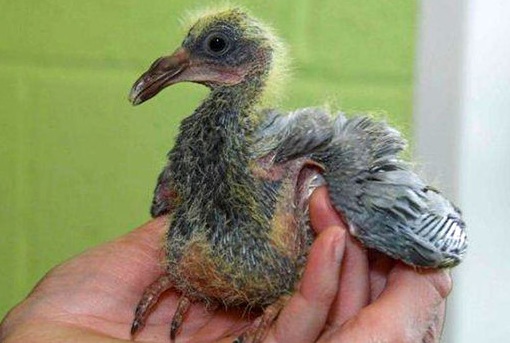
Langstone
Mill Pond
Peter
Milinets-Raby popped out this afternoon with the
family to visit Langstone Mill Pond (1pm to 2:15pm -
tide dropped away quickly). The highlights were as
follows:
Langstone Mill Pond: Cetti's Warbler heard singing,
Water Rail heard squealing twice, 20+ Goldfinch, 10
Teal, 1 Chiffchaff calling and showing well, 5
roosting Grey Heron, 1 Grey Wagtail over, 2 Skylark
over west.
Baby Mallard duckling still there and very bold, brave
and fun to watch when bread is being thrown to the
ducks. The duckling gets stuck in, not afraid of
anyone. It grabs a bit of bread and like a Kiwi Rugby
player dashes, zips, weaves it's way through the horde
of waterfowl to get to the safety of the reed bed,
where it eats it's pieces of bread, then ventures out
again. Great fun!! Also interesting to watch the
pecking order, as the Moorhen really do give the
duckling a hard time and often chase it into the
reeds!!
Off shore: 3 Greenshank, 70+ Redshank (B//-+B//YL), 4
Knot, 5 roosting Sandwich Tern, 15 Bar-tailed Godwit,
2 Black-tailed Godwit, 33 Teal, 8 Grey Plover, 5
roosting Cormorant, 5 Canada Geese over west, 31 Brent
Geese (all adults), 1 Turnstone, 231 Dunlin. Amongst
the Dunlin I eventually found the frosty grey
winter plumaged Curlew Sandpiper. It was really
too dark for photos. I took loads and the one attached
was the only passable one. Look for the curved bill.
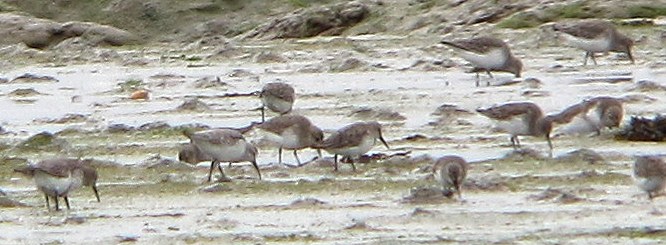
Walderton
Heather Mills
reported on this morning's walk by the Havant Wildlife
Group from Walderton to Stansted during which they saw
3 Roe Deer skipping through the fields . . .

and a Brown Hare among
lots of other interesting things.
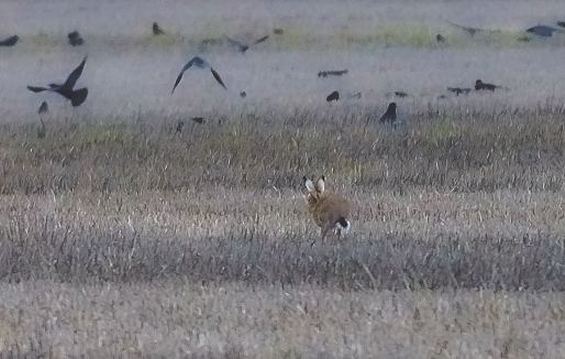
For the full
report go to . . . http://familyfellows.com/hwg-walk-reports-2015.htm
FRIDAY
OCTOBER 23 - 2015
Mystery
colour-ringed godwit
Pete Potts is
as mystified as I am about the colour-ringed
Black-tailed Godwit I had at Nore Barn yesterday which
looks like W+LW. Pete says "W+LW and B+LW (its looks
like a grey ring which could be faded blue) have both
not been seen for over 10 years...so most
unlikely...they are probably both dead but could they
come back from the dead?
B+LW last seen in 2001. W+LW last seen in 2002. L+LW
was ringed in 2010 with tall rings so it is not that
one".
The rings certainly
look old and dirty. Maybe it is back from the dead
indeed! I have been through all my 22 photos showing
the mystery godwit and I am sure the bird does not
have the regular red marker ring on the lower part of
its left leg. The photo below shows the bird lifting
its left leg and clearly there is no red ring. This is
strange as all Farlington ringed godwits have this red
ring. This raises the possibility that the bird is
from another ringing scheme. The metal BTO ring on the
lower right leg shows up well in many of the photos,
though I believe this is a standard ring for all
ringing schemes.
Mystery
solved - it is B+BL - see blog entry for Oct
25th

Dead
Owlet
My friends
Colin and Marion Harrington who live in Warblington
sent me the following photo of what they think is an
Owlet that was brought in by their cat. They think it
may have fallen out of its nest, though they have had
no sighting or sounds of owls in their area for many
years. When Marion picked up the corpse she was
surprised how heavy it was. Sam, the cat, is a stray
that spends its day roaming, so it could have come
from afar.
That is indeed very sad, but that is nature. There is
a high loss of young birds every year, including owls.
I agree the bird probably fell from its nest and was
found by the cat. It looks in a pretty bad state. Can
anyone confirm the identification of the corpse from
this photo?
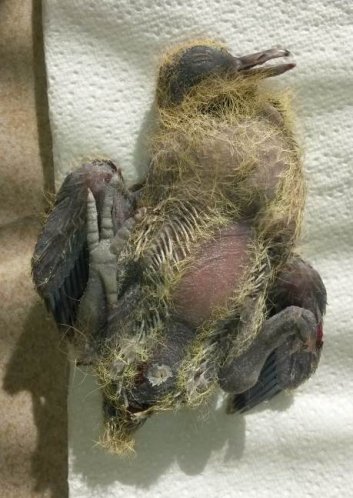
THURSDAY
OCTOBER 22 - 2015
Nore
Barn
09:30 -
Falling tide was just right for birdwatching at this
spot. There were two Spotted Redshanks in the
stream for the first time this winter plus the usual
colour-ringed Greenshank. The two Redshanks flew off
together towards Thorney Island while I was there. We
have frequently had two Spotted Redshanks at Nore Barn
over the years, sometimes even three! But there is
only one regular; the others are 'visitors'.
For more information on the Emsworth Spotted Redshanks
go to . . . http://familyfellows.com/x-spotted-redshank.htm
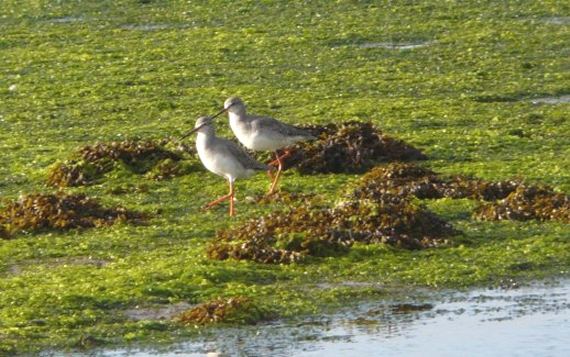
I had a good view a
flock of 86 Black-tailed Godwits feeding on the
mudflats in the creek south of the woods. They
included the two colour-ringed birds that have been
regular so far this winter and one mystery that I
could not read. The regulars were the Kent-ringed
ROL+RLR (on the right), the Iceland-ringed WO+LW flag
(in the middle) and the mystery with very dirty rings
(at the back on the left). Here is a photo of all
three colour-ringed godwits that I managed to capture
together.
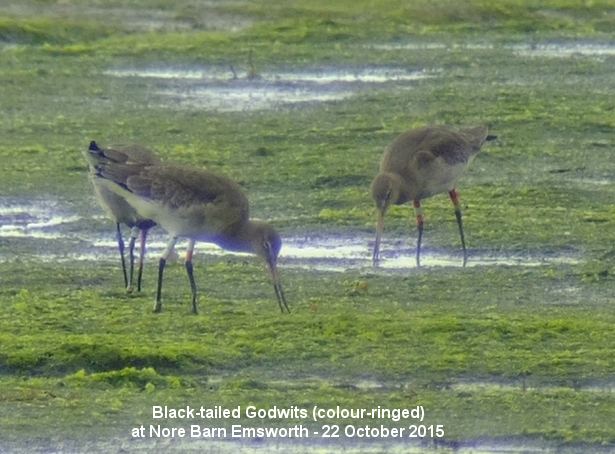
Here is a close-up
shot of the rings on the mystery bird which seems to
show W+LW, but I did not see any red marker ring on
the left 'ankle' which was present in all the early
Farlington ringings. The fact the rings are small
indicates that it is not a recent ringing; all recent
ringings use much taller rings.
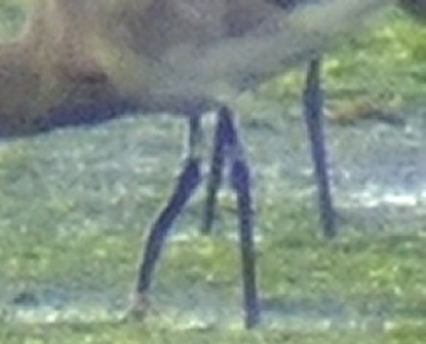
I have no record of
W+LW. I will ask Pete Potts to see if he has any idea
what it is.
There were lots of
Wigeon and Teal as usual plus a small flock of
18 Brent Geese far out - these were my first of the
winter!
Here
are female and male Wigeon (left) and male Teal
(right)
MONDAY
OCTOBER 19 - 2015
Brook
Meadow
I had a stroll
through the meadow and down to the Hermitage Millponds
this morning.
First, I went along the north path to have a look at
the river by the railway embankment which I was
pleased to find had a gentle trickle of water running
in it. Last week it was completely dry.

This is change is due
to the Environment Agency closing the sluice gates at
Constant Springs in response to a phone call from Ruth
Roberts complaining about the absence of water in the
river. Closing the gates at Constant Springs allows
more water to flow into the main Ems channel. Although
this has worked, it is important that a good flow is
maintained in the river to provide a good habitat for
wildlife, particularly in view of Andy Rothwell's
conclusion from his survey that the absence of Water
Voles was due to the low water level in the river.
I disturbed a Kestrel from the bushes near
Lumley copse. The Pike with the crooked tail was still
in the river north of the new brushwood shelving.
There is a fine show of Michaelmas Daisies on
the Lumley area and in the south meadow. The Wild
Angelica is also still in full flower in the south
meadow. Both these flowers were attracting insects to
their nectar.
Bumblebee
(Bombus pascuorum) - on the left and
Drone Fly on the right.
Hermitage
Millponds
On the east
side of Peter Pond I found some puzzling Mallow
flowers. The flowers as shown in the photo were
bright pink. I am fairly sure they were not Common
Mallow and I had to rule out Musk Mallow and Marsh
Mallow as the leaves were wrong. My hunch is that they
were a stunted Hollyhock. But any other ideas welcome.
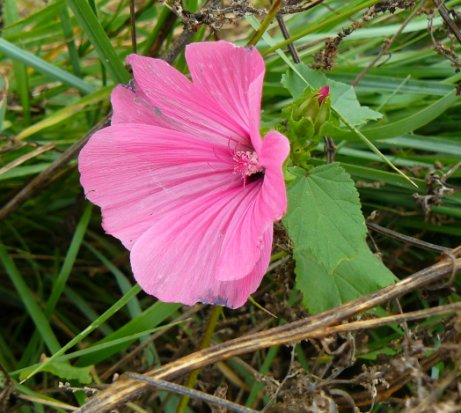
The local conservation
group have clearly been busy cutting and clearing the
grass verge on the east side of Slipper Millpond,
sensibly leaving several sections uncut as havens for
wintering wildlife. Particularly dramatic were the
various forms of Wild Carrot seedheads,

Here is the list of 21
plants I found in flower during the walk: Annual
Meadow-grass, Bramble, Bristly Ox-tongue, Common
Comfrey, Common Field Speedwell, Common Mallow, Common
Mallow, Creeping Thistle, Fat Hen, Hedge Bindweed,
Hogweed, Large Bindweed, Michaelmas Daisy, Perennial
Sow-thistle, Purple Toadflax, Red Clover, Shepherd's
Purse, Smooth Sow-thistle, White Dead-nettle, Wild
Angelica, Yarrow.
Bristly
Ox-tongue on the left and Hedge Bindweed on the
right
SUNDAY
OCTOBER 18 - 2015
Mute
Swan news
The resident
Mute Swan family on the town millpond was down to four
cygnets (including the white 'Polish' one) when I
passed by today. This is not surprising as cygnets
usually start to move off, or are driven off by their
parents at this time of the year. The 'visiting' pair
of swans remain on the pond, and can usually be seen
vying for territorial dominance with the resident
pair.
Photo
shows the cygnets on the left with the two parents. To
the right is the pair of 'visiting' swans

Nore
Barn
I arrived at
about 12 noon with about 3 hours to high water. There
was a nice flock of 31 Black-tailed Godwits
feeding on the mudflats, including two colour-ringed
birds, both regular wintering birds in Emsworth and
both previously seen this season. ROL+RLR (Kent
ringed) and WO+LW flag (Iceland ringed). Photo shows
ROL+RLR.

The colour-ringed
Greenshank (G+GL) was present in the stream,
but there was no sign of the Spotted Redshank today,
though I did not wait for the tide to push right up so
it could have come after I left.
Other birds present included 34 Wigeon and 54 Teal and
72 Redshank snoozing on the edge of the main channel
opposite the end of Beach Road. A man passing by
reported having seen a flock of Brent Geese in the
main Emsworth Channel earlier in the day. But I have
yet to see one myself!
Garden
Woodpeckers
I was
delighted to see a pair of Great Spotted Woodpeckers
in my back garden this morning. They had a go at the
fat balls and the seed feedsers, but seemed more
interested in the bark of the tree. The last time I
had Great Spotted Woodpeckers in the garden was in
January - maybe it was the same pair as they behaved
in much the same way.
Great
Spotted Woodpeckers in the garden
Male on left with red on back of head. Female on right
with no red on back of head
SATURDAY
OCTOBER 17 - 2015
Hedgehogs
and Bats
Caroline
French was pleased to hear about the Hedgehog family
in Paddy's garden in The Rookery reported yesterday.
She reminded us that the youngsters need to reach
around 600g in order to survive the winter and Brent
Lodge is there to help if needed.
Regarding Bats, Caroline has seen one on a couple of
occasions recently flying across her front garden in
North Emsworth and one across Horndean Road.
Caroline also saw her first Redwings of the year - 12
over the Sustainability Centre near East
Meon.
Langstone
Mill Pond
Yesterday Oct
16), Peter Milinets-Raby was at Langstone Mill Pond
ahead of the incoming tide between 10:02am to 12:06pm.
He walked in via Wade Lane and bumped into a very busy
tit flock consisting of 7+ Blue Tits, 4+ Long-tailed
Tits, 3+ Great Tits and 1 Treecreeper, 1 Coal Tit, 1
Goldcrest and 1 Chiffchaff. Also along Wade Lane were
2 Jay and a Green Woodpecker.
Flooded Horse Paddock:1 Grey Wagtail, 3 Pied Wagtail,
5 Moorhen.
Langstone Mill Pond: baby duckling still present and
getting brave, 4 Grey Heron & 1 Little Egret
roosting, 4 Teal, 1 Chiffchaff.
off shore Pook Lane: 11 Grey Plover, 6 Dunlin, 7
Greenshank (G//R+BRtag//- & G//R+YN//- &
NR//-+YY//- & RG//-+YY//-), 40 Black-tailed Godwit
(none with rings yesterday - today 7! Y//R+WY//- &
Y//R+BN//- & G//R+WN//- & R//R+GR//- &
W//R+YN//- & B//R+WG//- & WY//-+YW//- White
ring with letter "X"), 14 Bar-tailed Godwit, 17
Sandwich Tern roosting on mud (see photo), 6 Common
Gull, 25 Teal, 5 Skylark over west.
Off Conigar Point: 19 Brent Geese, 13 Shelduck, 136
Bar-tailed Godwit, 6 Knot, 22 Dunlin, 8 Wigeon, 7
roosting Cormorants.
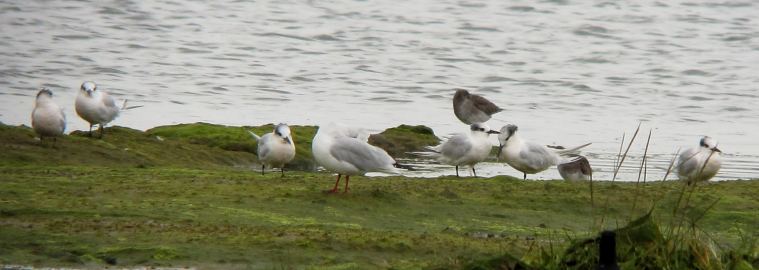
Water
Voles
Regarding the
Water Vole survey by Andy Rothwell reported yesterday
- of no sign of Water Vole activity anywhere along the
stretch of the River Ems on Brook Meadow - Ralph
Hollins remains optimistic that should the levels of
water in the river rise the Voles will return. He
says, "young voles will travel up to a kilometre,
sometimes overland, in search for a home of their own
when their mother chucks them out of the burrow in
which they were born". Well, we are doing our best to
get the habitat right for them, so let's hope Ralph is
right.
Meanwhile, Nik Knight (lucky chap) saw 2 Water Voles
at the Dolphin Spring in Havant this morning at around
09.10. One was swimming. The other was grazing, taking
grass down to the water's edge to eat it. Both were of
the relatively dark colour. I am envious.
Nutbourne
Heather Mills
reported on this morning's walk by the Havant Wildlife
Group during which 49 bird species were seen including
this nice gathering of Ringed Plover. For full report
go to . . . http://familyfellows.com/hwg-walk-reports-2015.htm

FRIDAY
OCTOBER 16 - 2015
Nore
Barn
11:15 - 12:15
Tide rising to high water at about 14:00. The
Spotted Redshank was already present in the
stream when I arrived.

It was later joined by
its regular feeding companion the colour-ringed
Greenshank (G+GL).
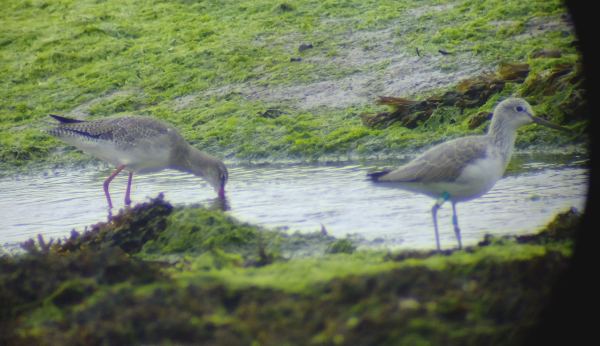
As I was leaving a
Rock Pipit also turned up on the edge of the
stream, quite close to the Greenshank.

I was pleased to see a
small flock of 18 Black-tailed Godwits feeding
on the mudflats. They later moved up the Nore Barn
channel to feed on the shore, giving better views from
the path south of the woods. There was one
colour-ringed bird:
WO+LW flag - This has been a regular wintering
bird in Emsworth since 2010. This was my first
sighting of this godwit in Emsworth this winter and
the 52nd overall since 2010. This bird was ringed as a
male chick in north Iceland by Ruth Croger and Pete on
13th July 2010 at Langhus, SW of Siglufjordur.

Of the migrant ducks I
counted 21 Wigeon and 42 Teal, but no
sign of any Brent Geese. I have yet to see one myself
this winter!
THURSDAY
OCTOBER 15 - 2015
BROOK
MEADOW
Two work
sessions were taking place on Brook Meadow this
morning; a regular work session led by Wally Osborne
and a special river management workshop organised by
the Arun and Rother Rivers Trust. So we had two groups
working separately and I had to dodge between the two
taking photos.
River
management workshop
This one-off
special workshop on river management was organised by
Ses Wright of the Arun and Rother Rivers Trust
assisted by Andy Thomas a Conservation Officer with
the Wild Trout Trust.
Andy gave a useful introduction to the purpose of the
workshop which basically was to improve the habitat
provided in the River Ems for wildlife, ie birds,
fish, plants and, of course, Water Voles. The River
Ems was regarded as having enormous potential as a
vibrant chalk stream, already having a good variety of
fish, including Sea Trout and the first spawning
Salmon.
Ses, Andy and a self-selected group of 7 volunteers
then donned thigh waders and set off down the river
from the north bridge, carrying their tools and
equipment in a small boat.
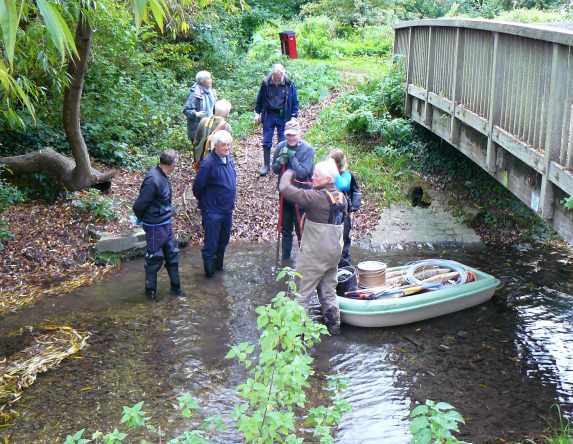
The main job was to
construct two shallow brushwood shelves, one on either
side of the river using cut twigs and branches all
held together by stout posts and rope, creating a
small meander. These shelves will be attractive to
fish and small mammals, like Water Voles. Also, a
'pinch point' was created just below the shelves and a
deep pool dug out to attract fish.

For more information
about the two trusts involved in today's workshop go
to . . .
Arun and Rother Rivers Trust . . . http://arrt.org.uk/
. . . Wild Trout Trust . . . http://www.wildtrout.org/
The
Pike
The river
management work took place beneath the old gasholder
close to where the lone Pike with the crooked tail
spends most of its time. Here are Andy and Nigel
looking at the Pike in the river.
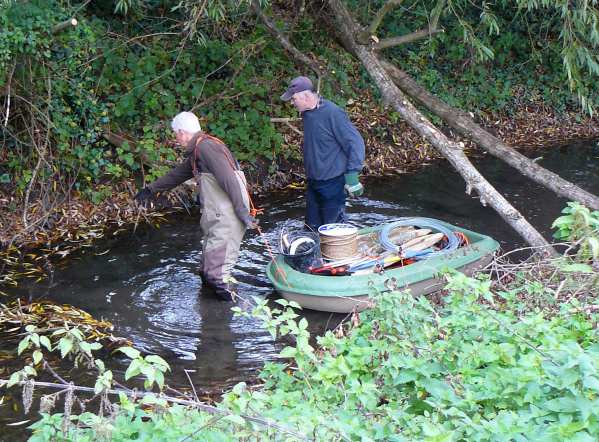
The fish is very
docile and, in fact, almost allowed David Search to
pick it up at one point. Andy Thomas agreed that it
appeared to be injured in the tail area hindering its
mobility. One can see traces of red which is probably
blood from the injury in this photo that I got of the
fish today.
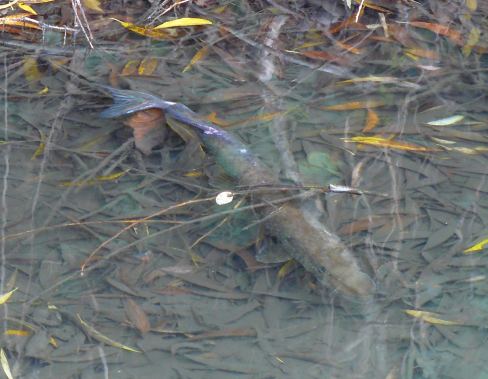
Conservation
work session
While the
river management was taking place, Wally Osborne and 5
volunteers tackled two other jobs. One was to remove
the temporary twig fences that were placed around the
main orchid area in preparation for the area being cut
and cleared on a future session. The other job was to
prepare an area on the north meadow south of the north
bridge as an experimental wild flower seeding area in
addition to the large area which was prepared a few
weeks ago further north. Seeds sown were Yellow
Rattle, Corky-fruited Water-dropwort and Common
Knapweed. Photo shows Wally strimming the grass and
volunteers raking.

More photos of the
river management workshop and the workday
will
soon be on the
Brook Meadow site at . . . http://www.brook-meadow.hampshire.org.uk/bm-diary-2015b.html
Water
Voles - bad news
I am afraid
the news on the Water Vole front is not good. Jennifer
Rye and David Search have heard from ecologist Andy
Rothwell who was commissioned by the conservation
group to carry out a Water Vole survey on the Ems.
Andy has done two previous surveys for us and the
reports can be seen on the web site at . . .
http://www.brook-meadow.hampshire.org.uk/
Previously, Andy had
always reported a good population of Water Voles, but
not this time. The present survey was on Saturday Oct
10 and drew a complete blank! Andy found no signs of
Water Voles anywhere along this stretch of waterway,
though he did see signs of Brown Rats all along the
river. Andy's conclusion is that the voles have
disappeared due to the lack of water in the river
rather than as a result of the previous winter 2013/14
floods.
See Andy's very alarming survey map summarising his
results . . . water-vole-survey-AR-10.10.15.pdf
Andy's survey confirms
the earlier survey by Jennifer Rye and David Search,
which had similar negative results, and also our own
lack of sightings over the past year. We have always
realised that our population of Water Voles was small
and vulnerable and could disappear at any time; but
now it has happened and we must try to do something to
get them back!
Only 11 sightings of Water Voles have been recorded in
2015, the last one being on April 30th. Malcolm
Phillips got the last photo of a Water Vole on the
river on Brook Meadow on April 23rd. Here it is, so
take a good look, it may be the last one ever!
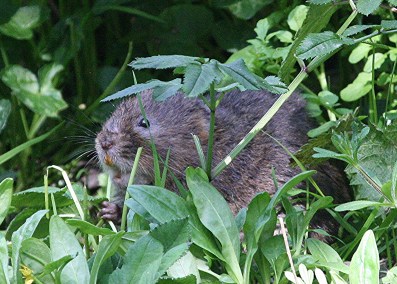
For
full Water Vole records go
to . .
. . http://www.brook-meadow.hampshire.org.uk/bm-water-voles.html
It is not all doom and
gloom for there are Water Voles in the local area, if
not on Brook Meadow. Andy Rothwell found a few signs
in the Lumley Stream during his survey, so maybe those
will be able to make their way across the meadow to
the main river. I believe they have also been seen in
the gardens of Lumley Mill and Constant Springs. Also,
promising was the sighting of a Water Vole in the mill
stream near Westbourne by Brook Meadow volunteer Dan
last week. So, all hope is not lost. What we need to
do now is create the right sort of habitat to
encourage them to move in here. Another possibility is
to have some reintroduced, but that is probably a long
way off.
Harvest
Mouse
The best news
in the Andy Rothwell survey was his finding a Harvest
Mouse nest on the west bank of the river behind the
Bulrushes. Harvest Mouse nests are occasionally seen
on the meadow and we had two reported and photographed
by Malcolm Phillips in June and July last year.
Bumblebee
I spotted a
Bumblebee (Bombus terrestris) worker
with large pollen sacs feeding on the Wild Angelica
flowers in the south meadow.
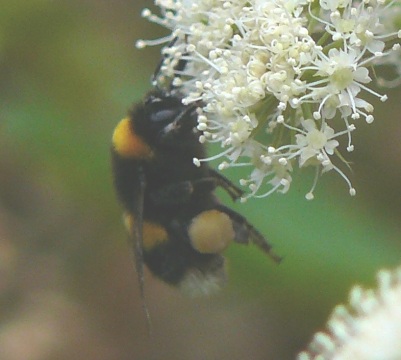
White-flowering
Comfrey
What I think
is Common Comfrey is still in flower in the south
meadow with white flowers. I decided to compare the
plants with those on the A259 wayside near Emsworth
surgery, which Ralph Hollins thought could be White
Comfrey (Symphytum orientale). I was surprised to find
many of the flowers on the wayside plants had a
distinctly pink hue, which strongly suggests they are
not White Comfrey, but rather white-flowering Common
Comfrey like those on Brook Meadow. The sepal teeth on
both plants were thin and deeply cut, also suggesting
Common Comfrey. Here are two photos I took today. The
white flowering Common Comfrey on Brook Meadow on the
left and the pink flowers of the ?? Comfrey on the
A259 wayside on the right.
Another
Hedgehog family
While walking
through Brook Meadow, I met my friend, Paddy who lives
in The Rookery next door to where Ted and Penny Aylett
used to live. She told me she has had a family of
Hedgehogs in her garden, two adults and two
youngsters. She thinks they are attracted by the food
that she leaves outside for the cat. This is the first
time she has ever seen a family group in her garden
which overlooks countryside. Caroline French recently
told us about the Hedgehog family she has in her
garden in North Emsworth - see blog for Oct 9. How
many others are there in the local area I wonder?
Langstone
Mill Pond
Peter
Milinets-Raby had a little wander around Langstone
Mill Pond this morning as the tide pushed in (10:38am
to 11:44am).
Off shore: A nice selection of waders including, 14
Black-tailed Godwits, 23 Bar-tailed Godwits (with 130
in the distance off Conigar Point), 6 Grey Plover, 26
Dunlin, 1 very smart looking pale, frosty winter
plumage Curlew Sandpiper (It flew off with the Dunlin
towards Thorney Island), 1 Knot, 3 Greenshank
(G//R+YN//- & G//R+BRtag//-), 60+ Redshank
(-//B+B//GN & -//B+B//NG & -//B+B//YL), 6
Common Gull, 35 Teal, 14 Brent Geese, 14 Sandwich Tern
roosting on the mud, then impressively flew off as a
flock over the Hayling Bridge into Langstone
Harbour.
Pond: Baby Mallard duckling still hanging on, 2 Teal,
Female eclipse Shoveler, Cetti's Warbler Heard, 3
Little Egrets and 2 Grey Heron roosting, Chiffchaff
heard, Great Spotted Woodpecker, 1 Grey Wagtail.
WEDNESDAY
OCTOBER 14 - 2015
Nore
Barn
I popped into
Nore Barn on the way to Chichester at about 10am this
morning. The tide was rising to high water in about 3
hours, but the tide was still well out and there was
no sign of anything in the stream. Richard Hallett was
also present in response to my notification about the
arrival of the Spotted Redshank for the 12th winter
running. What a remarkable bird! It was good to see
Richard again, but I had to get going so left him to
it.
After I left, Richard walked along the shore and got
back to the stream by about 11am where he found three
waders busily feeding, including a Spotted Redshank,
the colour-ringed Greenshank (G+GL) and another
Redshank, which I am pretty sure is a Common Redshank
from Richard's photo. They were accompanied by a
Little Egret.
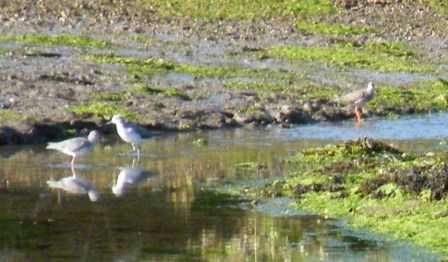
Emsworth
bats
Nik Knight was
delighted to hear about the Pipistrelle Bats on the
Emsworth foreshore at the bottom of King Street from
Lynda Harris (reported yesterday). He will try to get
down there to have a look soon. He thinks there might
be Daubenton's bats too, which fly very close to the
water and make more of buzzing sound audible at lower
frequencies than the Pipistrelles.
Night
sounds
Lynda Harris
arrived late one evening at Emsworth Railway Station
and was surprised to hear lots of 'insect noise' in
the wildlife area beyond the ramp, despite all the
work at the lower end. She wonders whether the insects
have moved up the hill giving higher densities and
asks would these be crickets of some kind?
Minsmere
RSPB
Tony Wootton
sent me some photos taken during a visit to the
Minsmere RSPB reserve. I have picked out a couple of
interesting ones. Tony was lucky to spot this pair of
Stone Curlew (on the left), but this magnificent stag
Red Deer in rut (on the right) could hardly be missed.
TUESDAY
OCTOBER 13 - 2015
Late
strawberry
I had a lovely
surprise this morning when my wife presented me with a
perfectly formed miniature strawberry that she found
in the garden. I did not have the heart to eat it as
it was so beautiful, so I put it on my work desk for
display along with all the other bits of nature that I
collect on my walks.

Bats
in Emsworth
Lynda Harris
Paysagiste writes to say that she and her parents,
Lesley and Keith Harris, have recently been enjoying
watching the aeronautic displays of bats on the
foreshore at the bottom of King Street, Emsworth. This
evening they borrowed the bat detector from Debbie
Robinson of the Brook Meadow Conservation Group which
showed that the bats were loudest on the 55 kHz
frequency so they are probably Soprano Pipistrelles.
They counted five bats feeding together. They came out
at about 6.30 and were easy to see - plus a wonderful
sunset too!
PS I have passed this
information onto local bat expert Nik Knight.
MONDAY
OCTOBER 12 - 2015
Nore
Barn
I did not get
any joy on the bird front today. I checked Nore Barn a
couple of times, once before high water and once after
high water, but there was no sign of the Spotted
Redshank (or Greenshanks) on either occasion. My one
and only sighting of the Spotted Redshank at Nore Barn
this winter was on 07-Oct-15. I am pretty sure it is
here, but it has yet to settle down in a regular
feeding routine.
Regarding the two colour-ringed Greenshank seen here
yesterday by Peter Milinets-Raby, I forgot to mention
that Greenshank YO+YY was last seen at Nore Barn at
this time last year on 07-Oct-14. G+GL is the regular
Greenshank at Nore Barn.
Railway
Wayside
I had a look
at the wayside to the north of Emsworth Railway
Station where work is progressing on the construction
of the new cycle rack. Today, the chaps were laying
the concrete foundation. I see from their jackets they
are HBC employees, so the project is clearly being
funded by the council, even though the land is owned
by Southern Railway. Incidentally, I can now see why
the brambles were cleared - to make way for the
vehicles that have to access the site via the highways
track to the north.

There are still a good
number of wild flowers to be seen from the railway
access ramp, including a spray of bright Hoary
Ragwort peeping through the wire fence.

On the other side of
New Brighton Road work is progressing preparing the
Interbridges Site (east), presumably for the
proposed industrial development. Here is a view from
the end of the path from Seagull Lane.
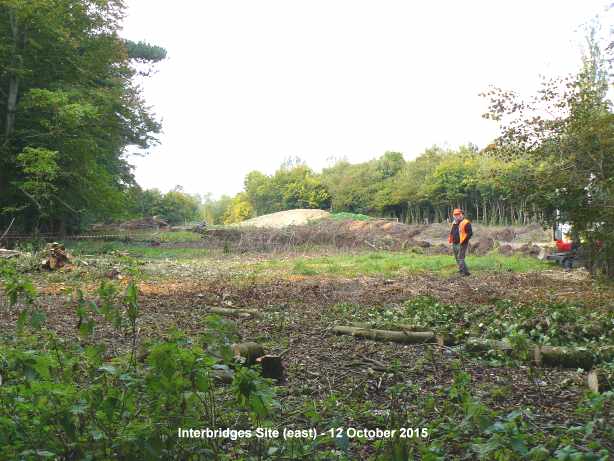
Brook
Meadow
Moving over to
Brook Meadow, I got a nice view of a flock of around
10 Long-tailed Tits feeding in the Crack Willows to
the north of the north bridge. I took some photos, but
I am no where near as good at this as Malcolm Phillips
who is away in Cuba.
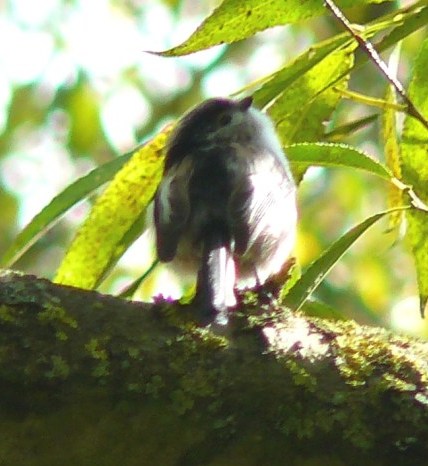
The north river is
almost totally dried up and has no water coming under
the railway arch from Constant Springs.
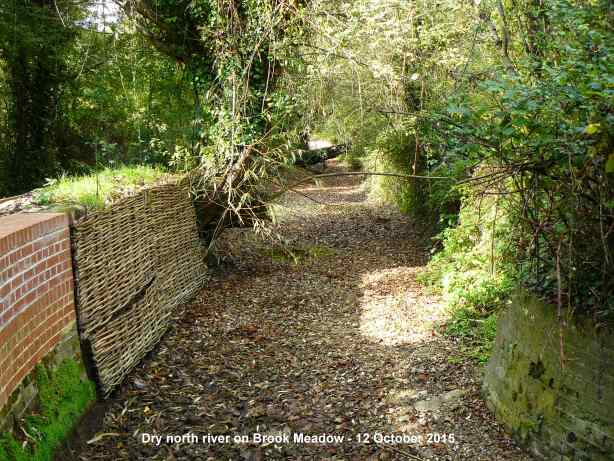
I checked the sluice
gates at Lumley Mill and they were closed thus
allowing water to flow into the main river through
Constant Springs, but there was basically no flow.
While checking the
Lumley Mill sluice gates I could not help but admire
the huge log pile in the enclosed piece of land to the
north of Constant Springs which I assume belong to
Constant Springs. What a magnificent hibernaculum it
would make.

White-flowered
Comfrey
Regarding the
White-flowered Comfrey growing on the roadside
embankment near the doctor's surgery in Emsworth,
Ralph Hollins is still in favour them being White
Comfrey rather than Common Comfrey. Here is his
summary of what his three main books say about the
differences.
'Blamey,
Fitter and Fitter stresses that White Comfrey has pure
white flowers and has leaves that never run down the
stem. It is happy to grow in drier places than Common
but never grows higher than 70cm whereas Common can
grow to well over 1 metre tall, never has pure white
flowers, and is usually found in damper places.
Marjorie Blamey's separate illustration of the calyx
of the Common Comfrey shows the longer calyx teeth
that I expect.
Stace's key uses the decurrent stem wings as its key
factor for Common and says .. "stem-leaves strongly
decurrent, forming wings on stem running down for more
than 1 internode". Stace's key factor for White
Comfrey is "calyx divided less than halfway to the
base, plus corolla pure white" (i.e. no hint of pale
yellow which is always true of Common).
Francis Rose adds that the leaves of Common are
'soft-hairy' whereas White leaves are 'softly downy',
and he also says that the calyx teeth of White are
only half the length of the calyx tube while those of
Common are twice the length of the tube and are narrow
and pointed.'
My photo of the
flowers on the Emsworth embankment shows deeply
divided calyx teeth more than halfway to the base
which suggests Common Comfrey. Also, the flowers are
not pure white. Ralph intends to have another look at
the plants and, no doubt, will report back.
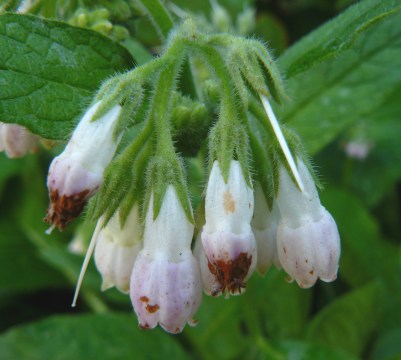
Hampshire
Farm
Chris Oakley
reports they are having problems with horse riders
coming onto the Hampshire Farm site. He is concerned
that they may damage the soft grass paths and render
them unusable by walkers. We have not had this problem
on Brook Meadow, but I know it has been a problem over
the years in Nore Barn Woods and in Hollybank Woods.
But they solved it by keeping horse riders' to the
special hard core paths.
Chris got pictures of a couple of late butterflies on
the Hampshire Farm site: Small White and Small Copper,
both not unexpected in October.
Chris also came across
Badger paw prints in the mud a couple of days ago.
Chris says, the only sett was abandoned some years
past, so thinks they were just visiting.
He also comments that Hornets are present along one of
the hedges, they seem very placid but will keep clear
of them just in case. In fact, I gather Hornets unless
directly threatened at the nest are very unlikely to
sting.
Pipit
correction
Eric Eddles corrects my labelling of his photo from
Salterns Quay as a Meadow Pipit. As Eric rightly
points out the bird is a Rock Pipit - the dark legs
give it away.

SUNDAY
OCTOBER 11 - 2015
Langstone
Mill Pond
Peter
Milinets-Raby was out this morning at 6:45am and
covered all the sites between Emsworth Harbour and
Langstone Mill Pond - The details were as follows:
Emsworth Harbour (from 7:14am - tide slowly
pushing in): 1 Greenshank, 41 Black-tailed Godwit, 25+
Pied Wagtails moving over east (Heard several, then 5,
14, 1 & 5), 5 Little Egrets, 24 Turnstone, 5
Canada Geese over, 55 Brent Geese, Kingfisher on
pontoon.
Emsworth Mill Pond: 14 Coot, 6 Mute Swans.
Off Mill Pond outflow (from 7:30am): 2
Greenshank (G//R+NN//-), 6 Black-tailed Godwit, 3
Meadow Pipit over east, 19 Goldfinch over east.
Off Beacon Square (from 7:36am): 1 Little
Egret, 3 Grey Plover, 1 Black-tailed Godwit, 1 Yellow
Wagtail over east, 1 Pied Wagtail over east.
Nore Barn (from 7:46am): 10 Black-tailed
Godwits, 7 Wigeon, 3 Shelduck, 4 Teal, 2 Little Egret,
2 Greenshank (YO//-+YY//- and G//R+GL///-). No Spotted
Redshank.
Ibis Field (from 8:07am): 2 Goldcrest, 1 Grey
Wagtail, Siskin heard going over, 69 Collared Dove on
overhead cables, 3 Skylark over east, 1 Moorhen.
Conigar Point (from 8:20am): 5 Chiffchaff in
Tamarisk Hedge, 2 female type Pintail, 12 Teal, 8
Wigeon, 7 Grey Plover, 2 Greenshank, 1 Dunlin, 3 Brent
Geese, 2 Great Black-backed Gulls, 5 Skylark over
east.
Off Pook Lane (from 8:42am): 92 Dunlin, 82
Bar-tailed Godwit, 5 Grey Plover, 13 Brent Geese, 2
Meadow Pipit on sea wall , 10 Skylark over east (4, 2,
2, 2), Young male Stonechat, Little Owl in usual tree,
3 Black-tailed Godwit, 6 Greenshank, 1 Lesser
Black-backed Gull, 2 Swallow east, 18 Siskin east (11,
4, 3), 5 Sandwich Tern roosting on mud (see photo), 29
Teal, 1 Kingfisher on wreck by Mill, 5 Lapwing, Mute
Swan family (2 adults with just 5 juveniles - lost
one?).
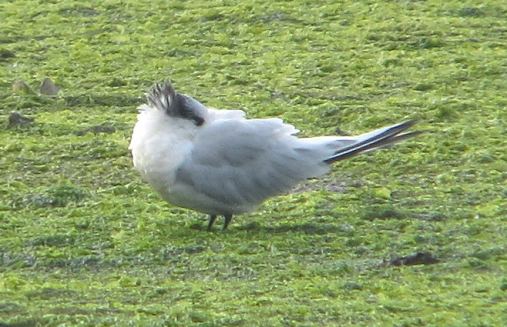
Langstone Mill
Pond (from 9:05am): 2 Chiffchaff, 5 Teal, Cetti's
Warbler heard, Siskin Heard going over twice, Eclipse
female Shoveler, Female Mallard with duckling
(STILL).
Castle Farm (from 9:55am) 3 Swallows east, 1
Chiffchaff.
Brian's
comments: Many
thanks as always to Peter for his brilliant survey of
the birds along this coastline. It just goes to show
the value of getting out early to catch the best
birds.
The 25+ Pied Wagtails in Emsworth were probably some
of those that regularly roost somewhere in the
millpond area. One can often see them around the
millpond at dusk.
It was good to hear about the arrival of Brent Geese
in Emsworth Harbour - the first of the winter. They
always take some time to move into Emsworth after
their early arrival in Langstone Harbour. It will be
interesting to see how many youngsters there are this
year.
The absence of the Spotted Redshank at Nore Barn was
not surprising as I have found it often takes some
time to settle down in a regular feeding routine.
Greenshank YO+YY was last seen at Nore Barn last year
on 07-Oct-14. G+GL is the regular Greenshank at Nore
Barn.
Salterns
Quay
Here are
another coupole of birds taken at Salterns Quay from
Eric Eddles library. Meadow Pipit and Guillemot.
SATURDAY
OCTOBER 10 - 2015
Salterns
Quay
Following the
news that Salterns Quay is to be demolished next
spring, I asked Eric Eddles who lives nearby to write
a short appreciation of the place:

"My wife and I have
spent many hours parked on Great Salterns Quay on the
Eastern Road observing the vast variety of birds.
Seasons have come and gone and we have never been
disappointed as there has always been something
interesting to see. Many hundreds of photos have been
taken and so I have selected just a couple." Common
Tern and Wheatear.
FRIDAY
OCTOBER 9 - 2015
Yesterday (Oct 8)
Ralph Hollins made several interesting botanical
discoveries during a cycle ride through Emsworth. He
was kind enough to e-mail me the details along with
directions as to where to find the plants. So, this
morning I cycled around checking on the plants.
Wild
Clary
I started at
Christopher Way where Ralph noted that some Wild Clary
stems were still in flower. I counted 11 plants in
all, most with small flowers open. All were on the
main council mown verge by a lamp post just a little
way east of the official wayside. I did find a few
Wild Clary flowers on the official site earlier in the
year, but now they are probably covered over by other
plants.
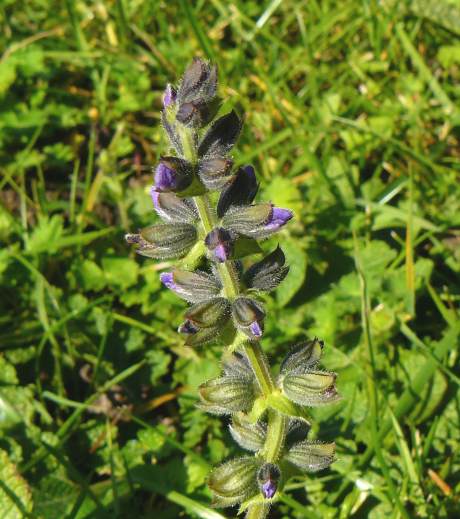
Dwarf Mallow
Going north
from Christopher Way along New Brighton Road, Ralph
came across a plant that he did not immediately
recognise, but later discovered it was Dwarf Mallow
(Malva neglecta). It was growing and
flowering against the outside of wooden fencing just
before the turning into Wensley Gardens.

Ralph had only seen
Dwarf Mallow locally once (at the north end of
Langstone Bridge a couple of years ago) since it
vanished from a regular site in the orchards at
Prinsted about five years ago. So, we have another
uncommon wild flower within a couple of hundred yards
of the Wild Clary at Christopher Way. Ralph checked
the seed shape in Stace which was correct for and
unique to Dwarf Mallow (including hairiness of the
seeds), thus confirming the identification.
Here
are the flowers and the seed pods of the Dwarf Mallow
on New Brighton Road
I found the Dwarf
Mallow easily by the fence in New Brighton Road and
took a few photos. My only previous sighting of Dwarf
Mallow was many years ago at Prinsted. The 1996
edition of the Hants Flora describes it as locally
frequent, but with no records in our area as far as I
could tell from the distribution map. So, I suppose
Martin Rand would appreciate a formal record.
White
or Common Comfrey?
Ralph also had
a look at the embankment on the side of the main A259
outside the doctor's surgery where Winter Heliotrope
grows in profusion. This wayside has a good show of
what I have always put down as white flowered Common
Comfrey. However, they reminded Ralph of White Comfrey
and he suggested I should check them. These two
species are easily confused, but the key differences
are (1) the size and shape of the calyx teeth on the
flowers and (2) the presence or absence of decurrent
wings running down along the main plant stem from the
leaves.
I checked several plants carefully with photos and all
had long, deeply cut narrow calyx teeth which is
consistent with Common Comfrey; for White Comfrey the
teeth would be short and narrowly cut.

The wings were less
decisive. Some of the plants had narrow wings running
down the stem suggesting Common Comfrey, but they were
not as prominent as those on Brook Meadow. Based
mainly on the calyx teeth, my conclusion is that the
plants are white-flowering Common Comfrey.
Ebbinge's
Silverberry
Finally, when
Ralph was going down Slipper Road towards Thorney
Island he found two examples of Ebbinge's Silverberry
on the pond side of the road almost as soon as the
Great Black-backed Gull nest raft comes into view. He
said the bushes are inconspicuous but the scent of the
tiny flowers attracted Ralph's attention. I did not
have time to check on this plant (which I have never
heard of before), so it will have to wait for another
time.
Railway
Wayside
On my way home
I passed by the Railway Wayside at the north of
Emsworth Railway Station and was surprised to see it
transformed as a result of work to install the new
cycle rack. Much of the ground at the eastern end of
the site has been bulldozed and a large area concreted
for the racks. I was complaining about the invasion of
brambles following my last visit, but now most of them
have gone! It will certainly be interesting to see
what comes up in this virgin ground next year.
Here
is a view looking west along the wayside from the path
to the station.
The foundations for the cycle racks are in the
foreground.

Stansted
fungi
Jill Stanley
went to Stansted woods again this morning to see if
any interesting fungi had appeared after the recent
rain. She found a few Magpie Inkcaps, and quite a
number of False Death caps dotted about though some
were looking rather the worse for wear. However, she
was pleased to find a few Saffron-drop Bonnets
(Mycena crocata), of which
she photographed this one.
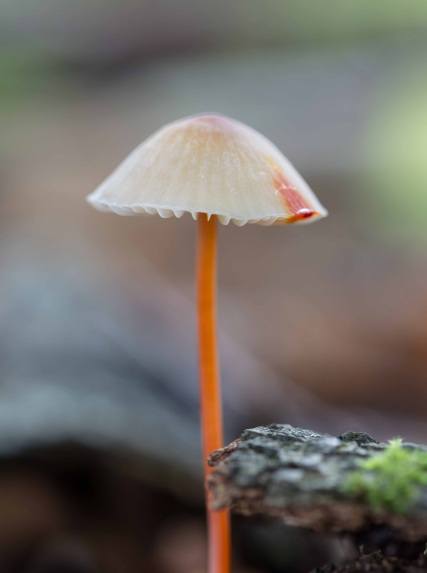
Jill also sent a
picture of some Stump Puffball
(Lycoperdon pyriforme) fungi that she
found elsewhere on the Stansted estate last weekend.
These are said to be quite tasty!
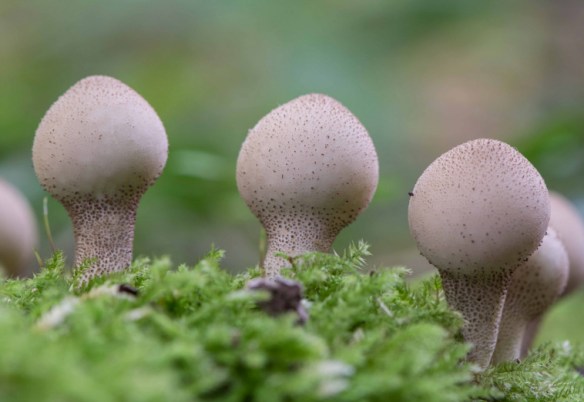
Jill says she has
managed to find and identify 22 different fungi at
Stansted this autumn, "not to mention the various
little brown things and so on that elude
me!"
Hedgehog
news
Caroline
French provides the following news update on her
garden Hedgehogs.
"The
female Hedgehog which had a litter earlier in the
summer is still occupying the same box in my garden
and has had a second litter. Each evening this week
from Sunday to Thursday, I found a small hedgehog in
my back garden - five in all! Two of them weighed just
over 300g and three of them were around 250g. I'm
hoping there will be no more but I will keep checking
the garden just in case.
According to UK hedgehog expert Pat Morris' book, 'The
New Hedgehog Book', this weight puts them at about
five or six weeks old, so they must have been born
around the beginning of September. Although I had been
anticipating a second litter, as I had seen the mother
mating after the first litter, I was completely
unaware of any young until this week. I estimate that
her first litter must have been born around
mid-June.
Unfortunately, all of them are far too small to be
able to put on enough weight to successfully hibernate
this winter, so they have been taken to Brent Lodge
Wildlife Hospital where they will be kept warm and fed
until they can be released next spring. Although it is
not ideal for them to be in captivity, this is
apparently their only chance of survival.
Although the mother is still around, each of the
hoglets was completely alone. I wonder whether the
mother has given up on them, sensing that they cannot
survive. In fact, the final hoglet, which I picked up
last night, had a superficial wound on its head and I
wondered whether this may have been inflicted by the
mother in an effort to drive it away - Brent Lodge
thought this was a possibility.
I continue to put food out for the hedgehogs each
night and I know that at least three adults are
visiting the garden (including the mother), although
there may be several more. Without marking individual
animals it is very hard to tell them
apart."
Here is a photo
of one of the hoglets, taken just before they all went
to Brent Lodge.
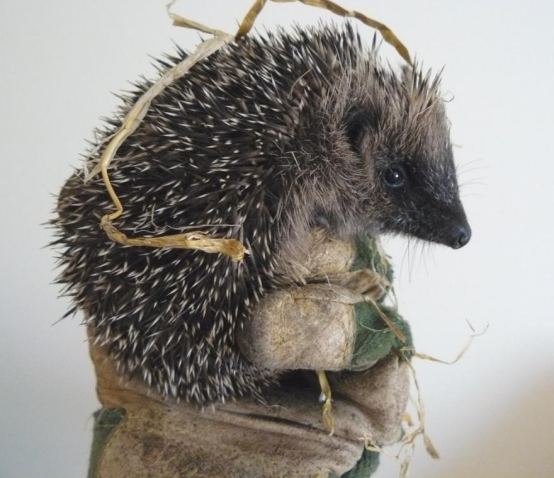
Langstone
Mill Pond
Peter
Milinets-Raby popped along to the Langstone Mill Pond
this lunchtime 12noon for an hour. Walked in along
Wade Lane. The highlights were as follows:
Along Wade Lane: 1 Kestrel, 3 Buzzard, 1 Chiffchaff, 1
Goldcrest, 1 Firecrest - by the big garden behind the
"castle tower" - see dreadful photo - Also photo
included from Thursdays early morning visit of the
Little Owl in its usual tree showing why I never find
it from one visit to the next.
Only managed to see it
because a Carrion Crow was giving it some hassle. 1
Nuthatch.
Horse paddock: 3 Moorhen, 1 Pied Wagtail, 2 Skylark
over with a single Meadow Pipit (heading west).
Langstone Mill Pond: 14+ Goldfinch flying around with
2 Siskin amongst them, 5 roosting Little Egrets,
Cetti's Warbler heard, 2 Chiffchaff (one singing
briefly), 7 Teal, 1 female eclipse Shoveler (so
different from the other day). Mallard female and
duckling hiding in the reeds as the Mute Swan family
swam by - just the female with five juvs. The male was
off shore, but no sign of the sixth juv.
Off shore (high tide): 1 Greenshank roosting in the
small marsh, 30+ Linnets flying around the distant
island in the channel, 1 Lesser Black-backed Gull, 1
Lapwing, 1 Golden Plover, No other waders due to high
tide.
THURSDAY
OCTOBER 8 - 2015
Brook
Meadow
I went over to
the meadow this morning mainly to update the
photographic displays in the three signcases. It was a
beautiful morning and the all went well. A couple of
chaps from HBC were strimming the edges of the main
path while I was there. They were not familiar with
Brook Meadow so I filled them in a bit about the
history of the conservation group. They did a very
good job with the cutting and I took their photo at
the end of the work. John is on the left and George on
the right.
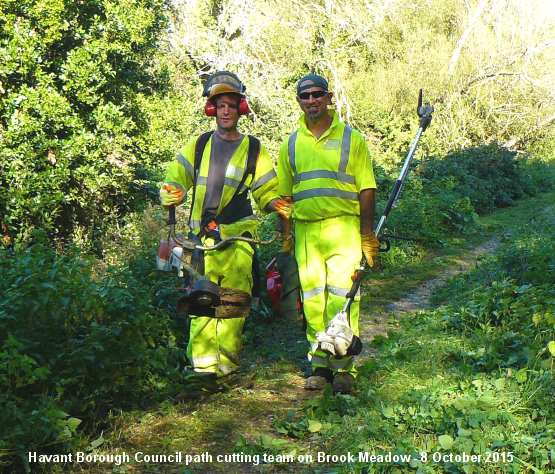
I had a look for the
Pike in the river and found it in its usual
place under the west bank south of the north bridge,
close to a pair of thin willow branches across the
river. I could not get a photo of the fish.
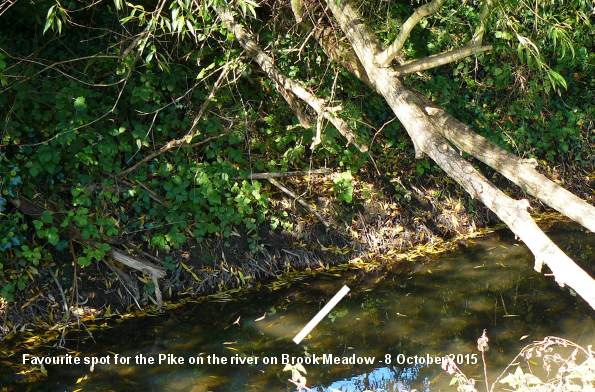
A little further south
a Moorhen was sitting in a bed of cut reeds. If
it were spring time I would have said it was on a
nest. Do Moorhens nest this late?
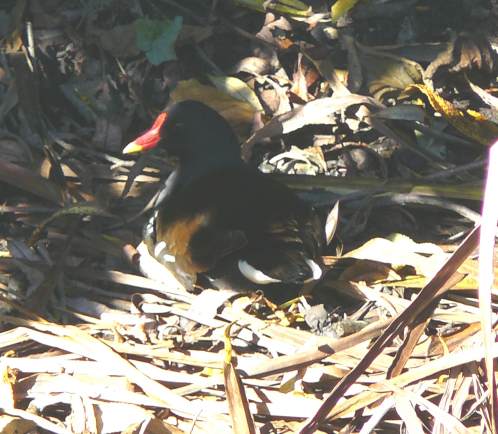
WEDNESDAY
OCTOBER 7 - 2015
Spotted
Redshank
11:00 - 11:30 - I went to Nore Barn to the west of
Emsworth about 3 hours after high water.
I was delighted to see a Spotted Redshank in the
stream feeding happily with its the now colour-ringed
Greenshank G+GL. This is almost certainly the same
bird that Peter Milinets-Raby first saw here on
27-Sep. I reckon it is also the same bird that has
been wintering here for the past 12 years! One can't
really tell this from the appearance of the bird,
though its behaviour is exactly what we would expect:
the time of its arrival is right, its relative
tameness and the fact that it feeds in the stream with
its regular companion the Greenshank. Here is today's
photo with Greenshank (left) and Spotted Redshank
(right).
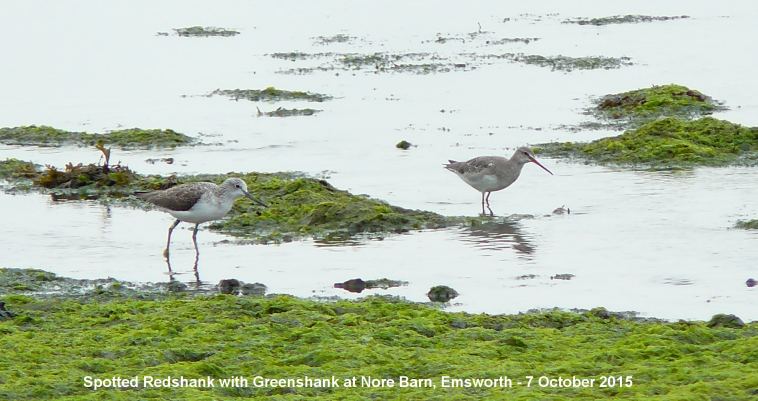
Black-tailed
Godwits
It was also
good to see a flock of 64 Black-tailed Godwits on the
emerging mudflats and around the stream. This was the
first good flock of Godwits I have seen this autumn at
Nore Barn. I expect numbers to build up during the
winter to around 150. Here are a few of them with the
Spotted Redshank also in the picture.
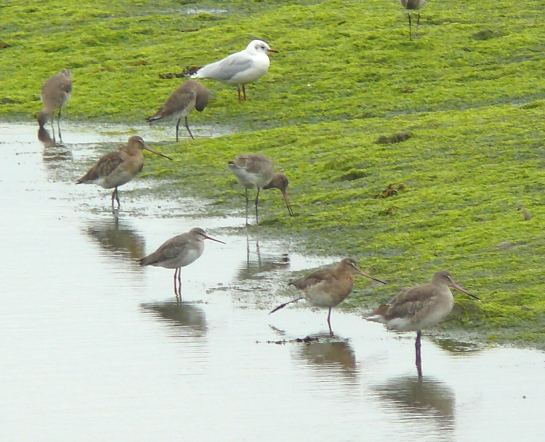
I did not have my
scope with me, but I managed to find one colour-ringed
bird which was fairly close to the shore:
ROL+RLR - This bird was ringed on 27-Oct-08 at
Kingsnorth Power Station, Medway Est. Kent as an adult
male. The fact that it has three colour rings on each
leg makes it fairly easy to spot, though a photo is
handy for getting the right combination as there are
others with similar combinations.
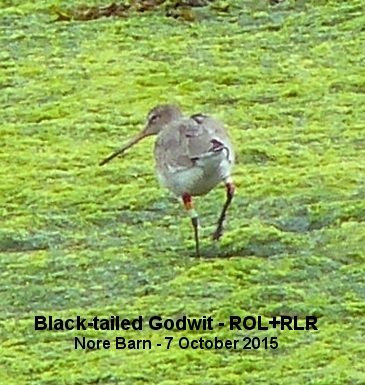
It was first seen in
Emsworth on 23-Oct-09 and has been a regular winter
visitor ever since then. Today's sighting was first of
this winter season and was the 83rd sighting in all.
It is often seen in Kent by Dudley Hird before it
arrives in Emsworth which shows it moves down the east
coast stopping in Kent on the way.
First
Wigeon
I was also
pleased to see the first Wigeon of the autumn, a male
and female together in the lower stream near the
godwits.
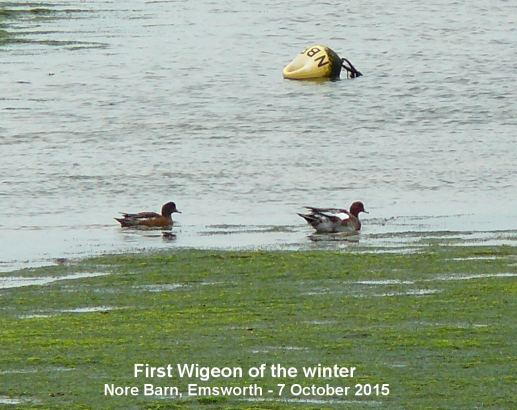
There was definitely
no sign of any Brent Geese anywhere in Emsworth
Harbour, west or east. I have not seen any here as yet
this winter period, though there are plenty in
Chichester and Langstone Harbours. They always take
some time to move into Emsworth.
Langstone
Mill Pond
Peter
Milinets-Raby was out briefly at 10:08am to 11am and
visited Langstone Mill Pond as the tide fell.
Langstone Mill Pond: 1 Kingfisher dashed across the
pond, Cetti's Warbler heard singing, Chiffchaff heard,
4 Teal, 1 male Shoveler in eclipse plumage - nice, 20+
Goldfinch flying around with 1 Siskin.
And, for all you softies out there, the baby Mallard
duckling is still alive and looking well. I think
having the Mute Swan family off shore is helping -
just 5 juveniles. Yellow Wagtail over.
Flooded paddock: 2 Pied Wagtail, 1 Grey Wagtail, 13
Teal.
Off shore: 8 Little Egret on the marsh, 1 Black-tailed
Godwit, 1 Lesser Black-backed Gull, 8 Sandwich Tern
resting on the exposed mud, 3 Dunlin, 147 Redshank
(see photo), 23 Brent Geese, 17 Grey Plover, 1
Turnstone, 21 Golden Plover, 6 Greenshank (RG//-+YY//-
& G//R+YN//- & G//R+RY//-),
Off Conigar Point: 22 Grey Plover, 30+ Dunlin, 1
Bar-tailed Godwit.

Short-eared
Owl migration
The British
Trust for Ornithology reminds us that October is the
peak month for winter visitors arriving from their
northerly breeding grounds and that one of these is
the Short-eared Owl.
See . . . http://bto-enews.org/NXN-3PEK7-3GJW16-1SGUDF-0/c.aspx
Around 1,400 pairs of Short-eared Owl breed in
Britain, mainly in the Pennines and the Scottish
uplands and islands, but we only see them here in the
south on passage or wintering. The BTO Birdtrack
reporting rate shows a clear peak in mid October,
perhaps as a result of arriving and departing birds
being found in well-watched coastal areas.
Locally, the best spots to see these superb birds are
Thorney Island, Pagham Harbour and Farlington Marshes.
I have one vivid memory of seeing seven of them
quartering an area of marshland near Tournerbury Farm
during a WeBS count in 2006. Here is a digiscoped snap
I got of one of them perched in a bush. Those eyes are
unmistakable!
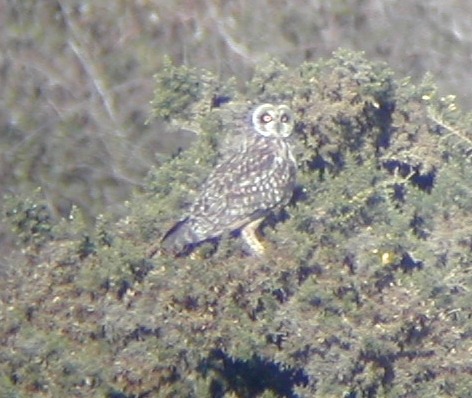
Water
Vole decline
Dave Lee notes
a letter in this week's Chichester Observer from Jane
Reeve, who is a Water Vole conservation officer for
the Manhood Wildlife and Heritage group. Her letter is
about the decline of water voles in the
Chichester/Hunston section of the Chichester ship
canal, so we are not the ones witnessing a decline in
numbers. However, I believe the Havant voles are still
very well.
TUESDAY
OCTOBER 6 - 2015
Harbour
Seals
Juliette Leach
got this cracking photo of several Harbour Seals on
the shallow sands on the West Side of Thorney the
weekend before last. Juliette says there were about 12
in all with some swimming.
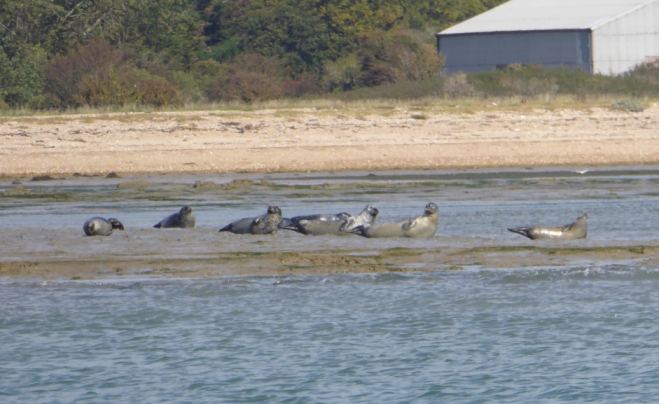
A number of Common
Seals (Phoca vitulina), also known as
harbour seals, live in the Solent. Each one has unique
markings and their colourings can be different ranging
from tan to grey, black and brown. The females are
generally smaller but with a longer lifespan. The
Chichester Harbour Conservancy web site estimates the
number of harbour seals visiting Chichester Harbour at
23-25, with 18 being the most recorded at any one
time.
For more information see . . . http://www.conservancy.co.uk/page/seals/375/
Juliette also spotted
these Turnstones resting on a buoy. Turnstones
are a regular winter visitors Chichester Harbour where
they number up to 300. We regularly see them in
Emsworth Harbour though in much smaller numbers (about
20 at a time). They can often be seen best when
resting on boats and buoys as in this photo.

MONDAY
OCTOBER 5 - 2015
Cygnet
eats Eel
Yesterday (Sun
4 Oct) Glynis Irons was fascinated to see the Mute
Swan cygnets on Emsworth Millpond trying (without
success) to eat an Eel. Glynis said "two cygnets held
the eel, one each end, but after a good few attempts
of trying to bite at it (they couldn't keep it in
their mouths) they both gave up. The Eel was dead and
just sank to the bottom of the pond."
Personally, I have
never seen or heard of this happening before. So, I
checked on the diet of Mute Swans in the Birds of the
Western Palearctic which said, as expected, that swan
food was mainly aquatic vegetation obtained from water
up to 1 m deep by full up-ending or by immersing head
and neck only (dipping); also emergent plants and
seeds by grazing and dabbling at water's edge, and
grasses and herbs by grazing on land. It also said
small animals were also occasionally but regularly
taken, including frogs, toads, tadpoles, molluscs,
worms, insects and larvae. But no mention of Eels! So,
this could have been a first - if it had succeeded.
Glynis also found the
first Tufted Duck of the winter season on the
millpond.

Signs
of autumn
David Minns
had a flock of at least 12 Long-tailed Tits in the
elder and apple trees behind his house in Emsworth
yesterday afternoon (Sun 4 Oct) as well as a Robin
setting up his winter territory.
Black
Swan at Nore Barn
Chris
Berners-Price found a Black Swan swimming around with
the regular white ones at high water at Nore Barn on
Saturday (Oct 3). This is the first Black Swan in the
local area for some time and probably the first one
ever at Nore Barn as far as I am aware. This could be
one of the birds from the West Ashling pond, though I
gather there are a good few in the local area.
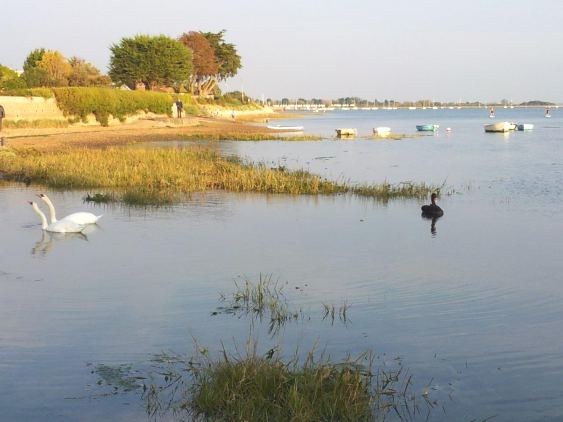
Thorney
birds
On Saturday
Oct 3, Barry Collins reported seeing 2 Ospreys on the
east side of the Great Deep and a flock of about 60
Golden Plovers flying around probably disturbed by one
of the Ospreys. The previous day, Barry saw a juvenile
Peregrine harassing 200 Dunlins at Pilsey Sands. There
were also 300 Dark-bellied Brent Geese off the
southern end of Thorney Island. Other birds of note
included 2 Short-eared Owls, 6 Wheatears, 10
Stonechats, 1 Whinchat, 4 Grey Wagtails, 10
Chiffchaffs, 2 Water Rails and 18 Seals hauled up on
the mudflats near Marker Point.
Red-backed
Shrike
This bird was
still present at Hayling Oysterbeds yesterday. Best
seen from the northern end of the Oysterbeds in the
hedges close to the steps up from the main path.
FRIDAY
OCTOBER 2 - 2015
Brook
Meadow
Malcolm
Phillips had a good time on the meadow this morning.
His best photo was of a male Kingfisher (all
black bill) that posed on a branch just up river from
the old gas holder. Why don't they ever do that for
me?
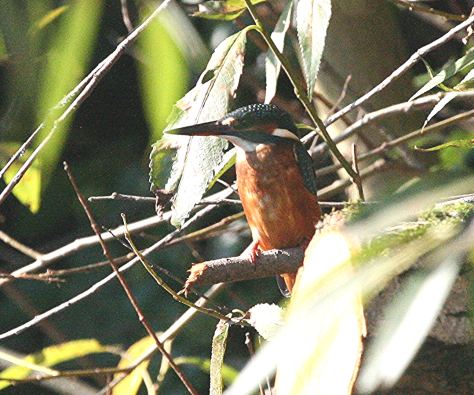
In the river almost
beneath the Kingfisher was the regular Pike
with the twisted tail which Malcolm also got a good
shot of.
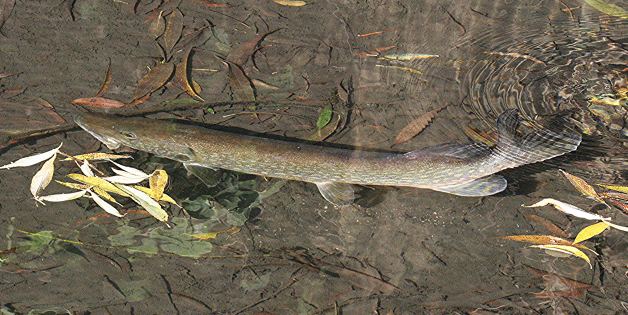
Other interesting
photos that Malcolm got on the meadow today were of a
moulting Blackbird, a Grey Wagtail in the river, a
Buzzard flying over head and a pair of mating Common
Darters.
Dave Perks and David
Minns also saw what was probably the same Grey Wagtail
as Malcolm where the river flows alongside the railway
embankment.
Common
Scoters tracked
Common Scoter
is Britain's most threatened breeding duck; its
breeding population has halved in the last twenty
years and it is the only breeding wildfowl species to
be red listed in the UK. To find out more about its
migration behaviour, researchers at the Wildfowl and
Wetlands Trust caught and geo-tagged four Common
Scoters last year. They were re-caught this year and
the tags retrieved. As the birds all came from a
single loch they were likely to be related and it was
thought they might migrate together to a similarly
small area to overwinter. However, the results were
quite unexpected.
The tagged Common Scoters went off in four different
directions; one travelled the short distance to the
Scottish coast, one flew hundreds of miles south to
the coast of Morocco and the other two went to
completely different locations in the Irish Sea.
All this suggested to the researchers that whatever is
causing the decline in Common Scoter numbers is more
likely to be in the summer when they're all together
in the Highlands than in their winter habitat. So, the
focus is now on the scoters' breeding sites; nest
cameras have been installed along with thermometers to
record the temperature under the egg clutches.
For more details go to . . . https://www.wwt.org.uk/news/news/2015/07/wwt-news/surprising-first-data-for-rare-british-duck/
Common Scoters are
seen from time to time in winter around the south
coast. I personally have not seen any for many years,
however, in early December 2014, a friend of mine saw
a flock of 12 while canoeing in the main Emsworth
channel. Peter Milinets-Raby occasionally sees them
off Langstone - e.g. 3 males were seen on Oct 14 2013.
But when Richard Somerscocks moved to Scotland a few
years ago he was delighted to find them fairly common
in Findhorn bay. Here is a fine shot Richard got of a
male in Feb 2013.
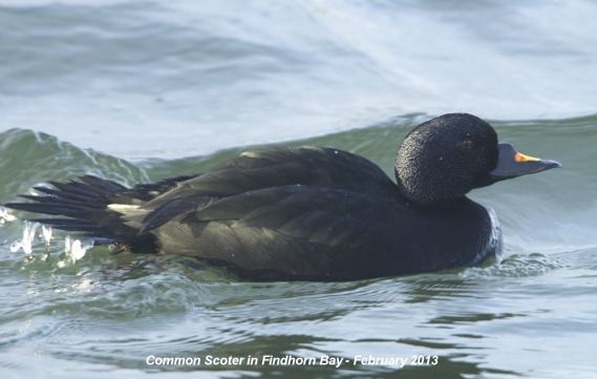
THURSDAY
OCTOBER 1 - 2015
Clouded
Yellow
Jean and I had
a stroll along Eastney prom this morning for a coffee
at the new Coffee Pot cafe on the beach - highly
recommended. On the way I saw my first Clouded Yellow
of the year feeding on Red Valerian on the beach. I
got a reasonable photo despite the strong easterly
wind.
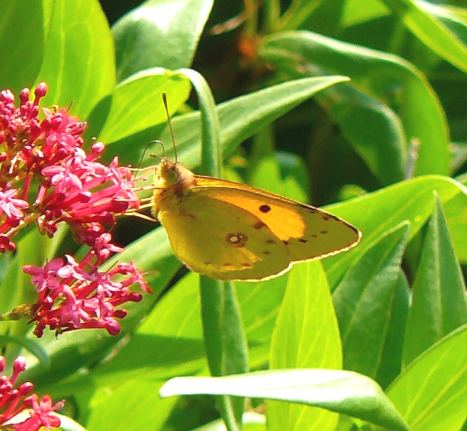
Clouded Yellow is a
migratory butterfly. Each spring they fly across
Europe to reach Britain's southern shores in highly
variable numbers, some years there are lots and other
years virtually none. However, even those that do
arrive here and manage to breed, very few survive the
winter. This raises the question of why do they bother
migrating if most of them perish. As I see it
migration is an evolutionary strategy of the species
to extend its range when conditions become favourable,
as will presumably happen with the global warming. The
individuals are of no consequence, it is the species
that counts.
Headless
Hornet
Ralph Hollins
provided an answer to the headless Hornet that I found
on the path yesterday at Nore Barn. Ralph thinks it
could well have been killed by a Hobby. Here is my
photo with the corpse of the dead Hornet being tackled
by a Common Wasp.
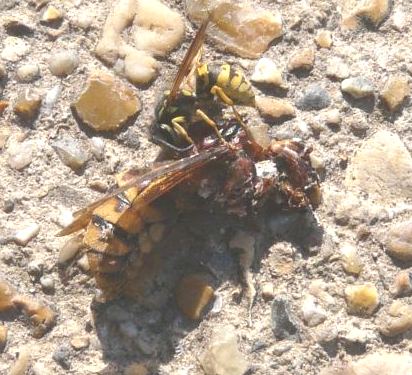
My first thought was a
big dragonfly could have been responsible for the
Hornet's death, but Ralph says no dragonfly is large
enough to capture an insect the size of a Hornet and
to hold it in the 'basket' formed by its legs while it
chews the Hornet's head off. However, a Hobby is a
sizable bird that could catch and hold a Hornet in its
claw; it would be quite likely to eat the head only to
avoid ingesting poison from the abdomen. Ralph has not
heard of this happening before and can't find any
confirmation on the internet. Has anyone else any
knowledge of a Hornet being caught?
Here is the best photo I have in my records of a Hobby
- taken by Colin Vanner at Arundel in Sept 2013. In
this shot the Hobby is being chased by a Crow or
possibly a Jackdaw.
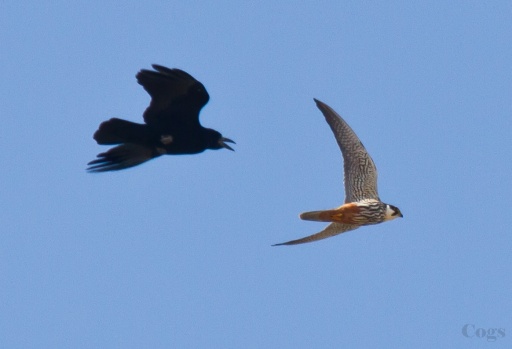
For
earlier observations go to . . September
17-30